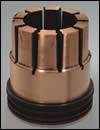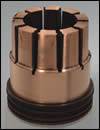Becoming a Master of Mold Material
The right mold material for the right job can have a tremendous impact on your manufacturing process, and sometimes that means trying something new.
Mold manufacturers serving various end markets with their mold design, build and repair specialties are always searching for ways to improve their mold builds, and appropriate mold material selection proves to have a dramatic impact. The right material for the right job can save time and money—keeping you competitive. Therefore, when it comes to mold material selection, tracking tooling and maintenance costs and considering wear resistance, thermo-conductivity, part geometry, cycle time, cooling/part stability, just to name a few, is essential.
Following is input from a few moldmakers and tooling engineers on the impact of the right mold material choice, the factors considered, the risks taken and the avenues tried when evaluating mold material options.
Over at MGS Mfg. Group (Germantown, WI) the toolmakers and designers are students of steel types. John Berg, Director of Marketing explains, “The choices they make with regard to wear resistance and thermo-conductivity are considered trade secrets. We make it a point to evaluate part geometry for best possible manufacturing. We also look to impact cycle time and cooling/part stability through material selection. Mold material selection has as dramatic an effect as cooling/water channels.”
David Hirt, a tooling engineer for Ventra Plastics (Sandusky, OH), has learned the pros and cons of the variety of mold materials employed for its automotive exterior lighting (P20 lens grade, 15-5 PH stainless steel and H-13), which dictate when and where to use each material—whether it be a headlamp lens, headlamp bezel, headlamp reflex lens, headlamp BMC reflector body or headlamp park/turn body.
“P20 lens grade is the lowest cost, but needs color matched when welded on a Class A surface, is the softest of the three materials and rusts very easily. 15-5 PH stainless steel welds fairly easily and does not need color-matched, does not rust and polishes the best, but it has a high cost and the lowest heat transfer. H-13 is in the midrange when it comes to cost, has the hardest surface, which helps prevent scratching and has the best heat transfer of these three materials, but it is the toughest material of the three to machine, and must be color matched when welded on a Class A surface,” explains Hirt.
P-20, 420SS and S7 are the three materials used the most for cavity steel at Byrne Tool (Rockford, MI) according to Operations Manager Andy Baker. As Byrne continues to grow and its customers demand jobs faster, they have tried other materials such as pre-hard 420, and looked into newer options like a steel called TOOLOX 44 (pre-hard steel at 44RC).
“We are always looking for ways to save time and money and buying a pre-hard steel can do that for you. However, we have not been able to make that change yet because of the difficulty with trying new products and running the risk of an outcome the customer is unhappy with—which would result in us needing to replace the material,” notes Baker.
Over at General Electric Appliances and Lighting (Louisville, KY), Tooling Engineer Tom Lynn, explains that for years he would specify hardened tool steel for almost everything—mostly S7 / H13 or stainless—depending on the plastic material. “Many of our programs are set to run 3 to 5 years and after tracking tooling and maintenance costs, we switched to a high hard P20 steel.”
According to Lynn those tools requiring stainless steel because of plastic material (RPVC mostly) were switched to a pre hard stainless steel, which saved considerable tooling cost. “A fully hardened tool needs to be rough machined, heat treated and finished machined. The hardened steel takes longer to machine, and heat treat takes time and additional cost. A mold from pre hardened steel can be finished faster, resulting in lower cost. For the most part high hard P20 is less expensive than S7 or H13,” says Lynn.
The company’s latest move has been to switch from high hard P20 to standard P20, which saved them additional money. “The hardness values of high hard P20 versus standard P20 is not all that different, and further, standard P20 is more readily available than the high hard P20,” notes Lynn.
After additional research and reviewing a program by a major automotive OEM, GE Appliances and Lighting switched from P20 to QC grade aluminum. This was dependent on estimated annual usage of parts from a particular mold. Lynn explains, “Aluminum may not be the best for each situation, but where it fits, there are great savings. Not so much in cost, but rather in mold cycle time, efficiency and design freedom. Some of our first aluminum production molds are running well after 100,000 + cycles. We expect these molds to run for up to five years, producing up to 70,000 to 80,000 parts per year.”
Wayne M. Hertlein, an Aerospace & Defense Applications Engineer for MMI Engineered Solutions (Saline, MI) also brings up aluminum, “With aluminum production molds we are always looking for an economically priced, high quality material that will last for the life of the program, and that has good polishability, repairability, compression strength and heat transfer. However, we do not want a lot of life left in the mold when we scrap the molds.”
Just this handful of moldmakers and tooling engineers sharing their insight demonstrates the importance of doing your homework, so you know when it is time to consider a new mold material option and just how to go about finding the right material for the right job.
Read Next
Making the Most of High-Performance Mold Materials
Understanding high conductivity alloys and optimizing their use can help you build better molds.
Read MoreHow to Use Continuing Education to Remain Competitive in Moldmaking
Continued training helps moldmakers make tooling decisions and properly use the latest cutting tool to efficiently machine high-quality molds.
Read MoreAre You a Moldmaker Considering 3D Printing? Consider the 3D Printing Workshop at NPE2024
Presentations will cover 3D printing for mold tooling, material innovation, product development, bridge production and full-scale, high-volume additive manufacturing.
Read More














